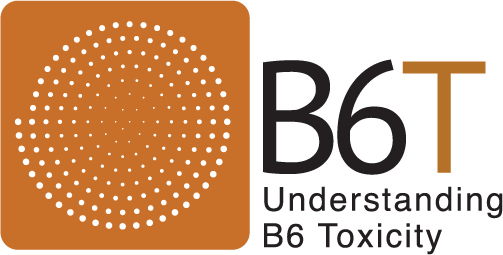The Basics
What is Rebound?
Rebound is the aftereffect of removing B6 from small fiber nerves. Rebound is paralyzed nerves waking up. These nerves wake up damaged. Damaged nerves are painful nerves . Damage nerves ALSO send signals to release vasodilators. Rebound then is BOTH paralyzed nerves waking up and a bombardment of vasodilators that hampers already low blood volume. Although it doesn’t sound like it, Rebound is the start of healing.
When does Rebound start?
As early as three months after the removal of excess B6 to as late as ten to twelve months.
What is important to start Rebound?
You need to remove the excess B6 from the nerves. The only way B6 comes out of nerve cells is through deprivation. The RDA B6 diet is the healthy way to reach deprivation. The goal is low normal blood work.
When does Rebound end?
The worst of rebound is about three to four months long. You will have flares after this.
What are Rebound flares?
Flares are reemerging symptoms for the next one to two years. Each flare is less in intensity. They are a combination of paralyzed nerves waking up and low blood volume symptoms due to excess vasodilators. The blog “Am I in Rebound” is a great resource.
How do I know when I’m out of Recoil and into Rebound?
There might be a honeymoon period between the two phases. It is a period of feeling better as short as two days to as long as six months.
How do we know this?
Information from the research, interpreted to fit member experiences.
Rebound and Nerves: The Research
We know B6 is in our nerve cells, and is resistant to depletion, due to Coburn’s devoted diligence on this topic. Coburn, et al, 2015 review of the research shows that B6 is a significant component of most tissues including nerve tissues. The same research discusses that B6 in tissues is resistant to depletion.
It is theorized by Berger, A.R. et al, 1992 that B6 stays in the local nerve environment after the removal of a high B6 dose in human subjects. Their paper entitled, “Dose Response, Coasting and Differential Fiber Vulnerability in Human Toxic Neuropathy: A prospective study of pyridoxine neurotoxicity” used the authors of the study as guinea pigs for this experiment. Once excess amounts of vitamin B6 were removed, serum levels normalized quickly, but symptoms progressively increased for the next few weeks. They suggested that increased symptoms were not due to higher B6 blood levels, but instead due to “TOXIN REMAINING IN THE LOCAL NERVE ENVIRONMENT”.
These authors who subjected themselves to the excess B6 in this study have the best first-hand knowledge of B6 toxicity. They realize that it’s not the excess B6 in the blood that is creating the increased symptoms in, but instead the B6 that has been stored in the nerves. In their continued discussion in this paper, they summarize that the lower dose (1 gram) subjects had predominately small fiber dysfunction. They suggest that in previous research on human subjects the small fiber dysfunction was ignored because it was overshadowed by the clinically more obvious large fiber dysfunction.
A known neurotoxin that creates small fiber dysfunction is being stored in small fiber nerves.
A known neurotoxin that creates small fiber dysfunction is being stored in small fiber nerves.
A known neurotoxin that creates small fiber dysfunction is being stored in small fiber nerves.
Another important piece of research is Coburn, et al, 1995 study. It shows that in humans B6 blood and urine levels decreased during a low B6 diet BUT stayed the same for those fasting. Although this sentence appears confusing, it is in line with members’ experiences. We will explain this in more detail below.
Rebound and Nerves: The Facebook Group’s Experiences
Rebound is not described in the literature. There are no long-term studies on the aftereffects of B6 toxicity on the nervous system. The only data that exists are the member-told stories within the Understanding B6 Toxicity Facebook group. Several members join the group AFTER they healed themselves from B6 toxicity. They described experiences were the same sensory, autonomic, and motor issues that the Facebook group was experiencing. We knew from their contribution that Rebound was going to happen. Period. This graphic drawn by group member, Thomas H., puts Rebound in a visual perspective. This graphic aid helps you understand the roller coaster of physical symptoms AND the emotions that you will be experiencing for the next year plus.
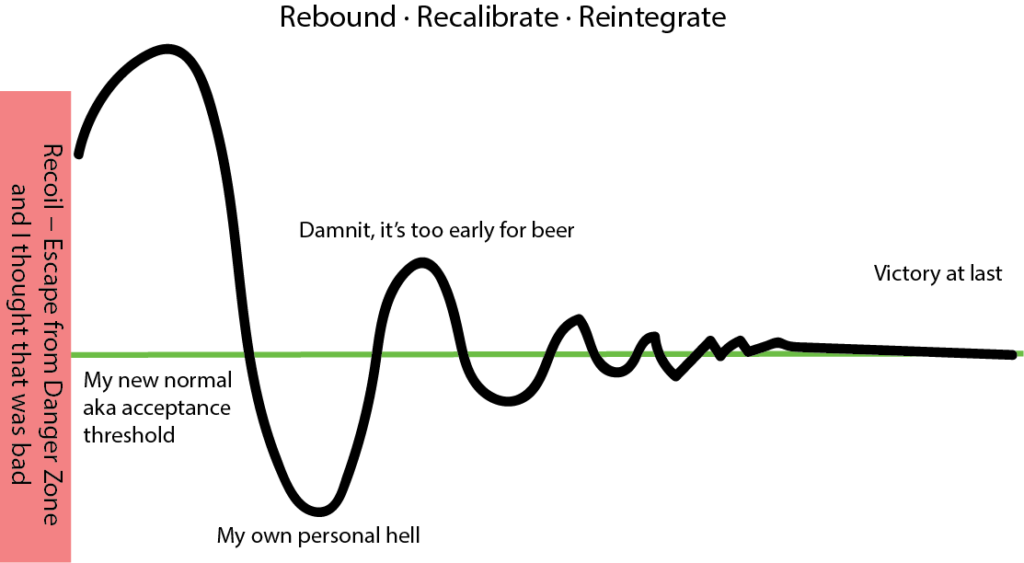
The below paragraph is from member Lyndon J. He was helping a new member understand the severity of Recoil and Rebound. His words clarify the intensity of both.
“Yes, they were pretty bad at the beginning/recoil and again during rebound (but not quite as bad). Couldn’t sleep laying down for 4 months, waking up every 10-15 minutes gasping for breath and burning acid under the skin, numb limbs at night, sometimes half of my whole body, neuropathy/pain in extremities and face, hot skin flushes/vasodilation, tiredness/exhaustion, heavy pressure on the chest like I couldn’t breathe, low blood pressure, sudden drops in 02, dizziness, joint pains, anyways list goes on! I would mostly cycle through one set of symptoms and then when they eased off a new set would start all over again. Most of the above are completely gone, I still get flare-ups but the heavy stuff is all gone. I’ve been on the protocol for about 8 months, I would imagine being back to normal in another 4 months or so, I would say I’m at about 75% recovered now. I don’t think it’s a problem reducing to normal B6 quickly, but what has been discovered in the group is that when you go BELOW RDA, that is when the symptoms become unbearable. Many of my really bad symptoms were during that classic recoil phase and then it started to taper – with many ups and downs. I managed to make it through without any drugs to handle symptoms; what was most helpful to me was having this group and knowing I would make it through, my neurologist begrudgingly made my diagnosis – which is hilarious for him to be uncertain for someone who had about 45 x the max range! Thankfully he checked with his other colleagues to finally make the diagnosis. I had many, many tests at my insistence – including nerve conduction studies.”
The following is from another member of ours, Chris F., who also shared his Rebound experience.
“This is rebound! I’ve been tracking my journey each day in a journal, and more so during rebound. And this is what it looks like. For those that have yet to hit rebound or just joining and are scarred and worried, there is hope. It’s not constant bad days for weeks and months. It’s not fun AT ALL, my anxiety did kick up some days, but you have good days.
On this, green day’s are good days, pink are bad days. Good days I still had symptoms, but they were bareable or not really bothering me. Bad days were BAD! Some days started good, and ended bad. But it’s never linear, it’s always up and down. But each day got a little bit less symptomatic, and a little bit better. As time went on, the bad days were more bareable.
I am currently at 9 months and 18 days into healing and today is 3 months exactly since rebound started. This weekend was a bad weekend, I only got 4 hours sleep Saturday night and symptoms flared all day Sunday and I didn’t leave the couch. Today…I’m running about 90% right now and got 6 hours sleep, and symptoms are barely noticeable. Yesterday I felt like crap, today I feel amazing.
It’s a crazy, unexpectable ride. This rebound lasted longer cause on January 9th I flew to Florida and a combination of the flying, some slight dehydration and a severe weather front all hitting at once kick started my symptoms into high gear for another 6 weeks. So without that happening, probably wouldn’t have been so bad. But this shows the worst of it lasting 6 weeks.
During this rebound my worst symptoms were my swallow reflex stopping causing me to lose 15lbs, lump in throat, severe dry mouth causing more swallow issues, random numbness in whole right side, neuropathy in feet, random sweats, occasional tremors, low blood volume, POTS symptoms including severe lightheaded moments standing or doing anything for almost 2 weeks, tinnitus, brain fog, and sleeplessness averaging 5-5.5 hours a night. But not all at once on one day. Some days it was just one or two, some it was 3 or 4, some days maybe just one symptom. But they all reared their head to say hi.
Currently, as of today, the swallow reflex is still lingering but not near as bad, so I’m able to eat better. And I have some lightheaded moments still, but manageable. I can tell healing has occurred, and is still happening. There are a lot of scratching out on my calendar, and that’s cause this healing journey is a day to day juggle during rebound. I had a lot of appts and plans that I had to scrap and cancel for time on the couch. We adjust, we refocus, and live life in the healing bubble. But on the other side is life again! You will see this too.
My key to all of this…I stayed STRICT to the protocol, tried to exercise daily even when I didn’t feel good (at a minimum yoga and meditation), and monitored every single thing going into my body on Cronometer. I even measured the salt and water on Cronometer. I didn’t take anything but my blood pressure med, Zyrtec on bad days, and occasionally the Kirklands sleep aid or zzquil, and I stayed right at or just under RDA. But I didn’t ask my body to do more than it needed or wanted. I let it tell me what to do, when to rest, and when to be active. Rest, heal, don’t continue to poison yourself with vasodilators, more supplements (unless you need more) or extra stuff you don’t need. This is a long, physical therapy journey but you have to do the work. But the work…does work!“
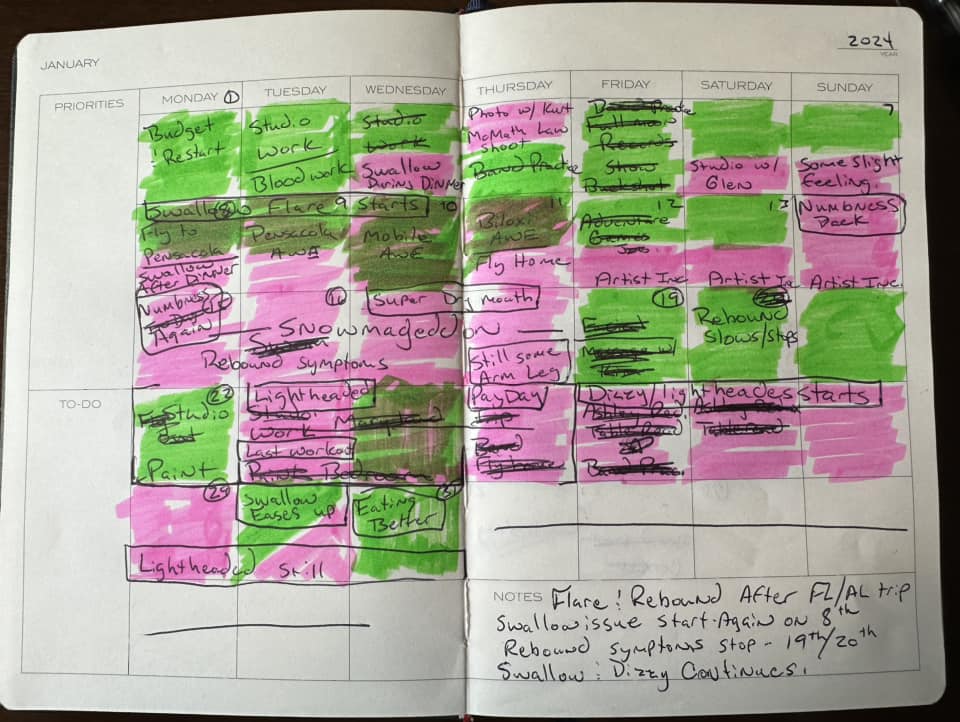
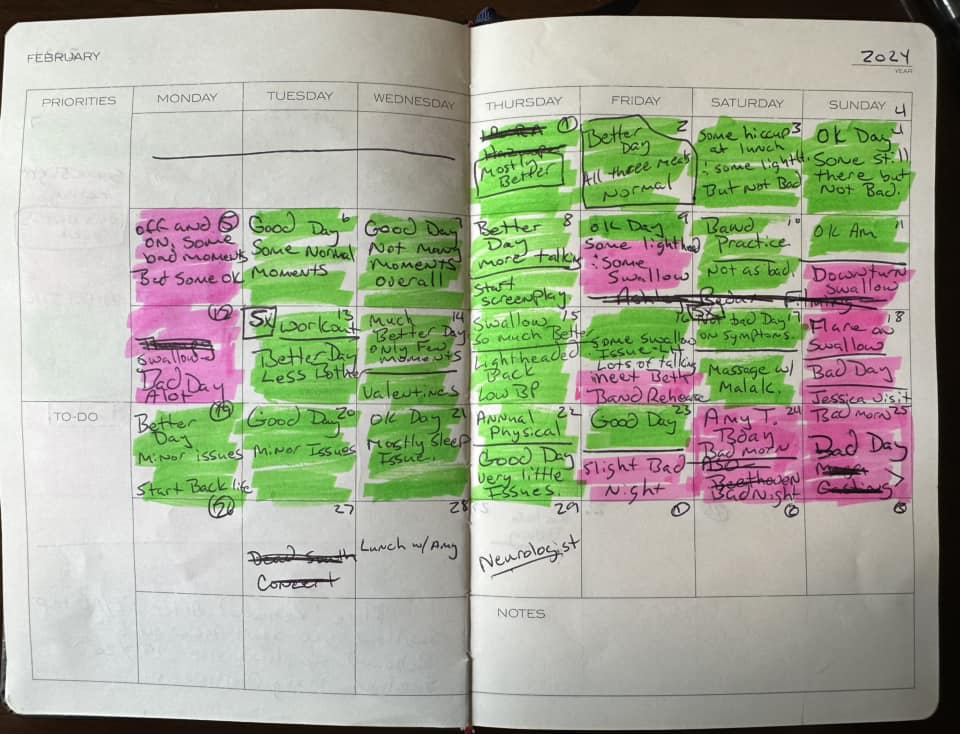
Member after member described these experiences. Members’ symptoms were more intense and for a longer duration than what is described as Recoil in the literature. Since there were several healed members who joined the Facebook group AFTER they went through Rebound, we knew it was part of the process.
But what process? What was going on? Why does the literature not describe this?
One of the group’s goals was to understand, explain and alleviate the intensity of Rebound for members. It took several years of diving into the research before we had a solid path that was possible for Rebound symptoms. We are the only organization that has identified this new phase. We are the only entity trying to understand it and explain it. We are the only organization that has created a Protocol to help get through the worst of it.
The first break in understanding Rebound was during the group’s first year. The Original Protocol was a low B6 diet with about the same hydration protocol. Members hit rebound all about the same time. The rebound was characterized by increased autonomic, motor, and sensory symptoms which included burning pain. The burning pain level was eight to nine on a scale of ten with ten being the highest. Rebound was harder on the Original Protocol.
Also, during this time, three members went almost no-B6 in their diet. This was never recommended. Their Rebound started faster. The burning pain was twelve plus on the same scale with ten being the highest. We recognized this as significant. We realized that the no-B6 diet created an environment worse than the low-B6 diet. This difference between the low-B6 diet and the never-recommended no-B6 diet was the reason we created the RDA B6 Protocol. As expected, the RDA B6 diet eased the pain of Rebound, but it also extended the timeline to heal.
Our consistently low-normal blood work suggested that the symptoms of Rebound were not due to excess B6 in the blood. The group’s B6 labs tests drop to low-normal within two to four weeks for those members following the B6T Smart Protocol. Results were consistently low-normal during the year plus of healing. This low-normal blood work showed us that the excess being removed from nerve and muscle tissues was not putting an extra burden on damaged nerves.
In the research section above, Coburn, et al’s, 1995 study showed that in human subjects B6 blood and urine levels decreased when a low B6 diet was consumed (lower than RDA). This is consistent with the Facebook group’s original protocol which was a low B6 diet. This research also showed that the subjects that were fasting for the 21-day experiment had B6 blood and urine levels that DID NOT decrease. Logically, the assumption is less food means the B6 values should go down faster. Yet, they remained the same. Coburn suggested that the body was pulling from an internal source. In this 1995 study, he suggested that the internal source was from the muscles. In a future study on deprivation, that measured muscle tissue, he did not find a drop in muscle B6 amount during fasting. The internal source is not muscle. Based on the members that went no-B6 at the beginning of the group with the subsequent head-to-toe burning leads us to believe that the internal source was B6 being pulled from the nerves. The head-to-toe burning at pain levels of 12 was a result of too much B6 being pulled from nerve cells at once; thus, waking up too many damaged nerves too quickly. Damaged nerves are painful nerves.
Around the third year of the group, it was theorized that the symptoms in Rebound could very well be nerves healing. We found evidence that healing nerves are indeed painful nerves in Medscape’s, Toxic Neuropathy Clinical Presentation. The author, Jonathan S Rutchick, states, “Spencer and Schaumberg emphasized a gradual insidious onset, as well as slow recovery. Recovery proceeds at a rate of 2 mm/day and may take months or several years. Function is restored in the reverse order to the sequence of loss. Intensification may occur for weeks before improvement. This often reflects continued axonal degeneration AND reconstitution.”
In English, the last two sentences of the paragraph above states pain increases due to damaged nerve clean-up and the regrowth of those nerves. If you are following the RDA B6 diet then the slower removal of B6 from the nerve cells means different nerves waking up at different times of Rebound. Members consistently report in that symptoms move from body part to body part during this time. As one section calms down, the next section acts up.
Also, in the above research is the statement “function is restored in the reverse order to the sequence of loss”. Members reported that the first damaged was the last to be restored. This statement also corresponds to “Rehab and Revive’s” Nerve Behavior Scale. The symptoms of nerve regeneration progresses in reverse of the symptoms of damaged nerves.
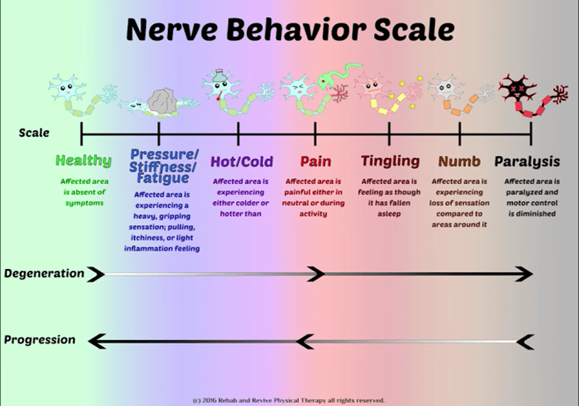
Rebound and Vasodilators: The Research
In the beginning of this section, we mentioned that Rebound is both nerves healing and a bombardment of vasodilators. It wasn’t until 2023 that this vasodilator piece of the Rebound puzzle fell in place. While researching the most potent vasodilator, calcitonin gene related peptide, one paragraph in Smriti, Iyengar, et al, 2017 paper stood out. “Tissue injury results in the release of numerous proinflammatory mediators from the injured cells, mast cells, leukocytes, and the nerve terminals. These substances include the tachykinins (vasodilator), bradykinin (vasodilator), prostaglandins (vasodilator), serotonin (vasodilator), histamine (vasodilator), as well as the release of CGRP (vasodilator) and substance P (vasodilator) from the nerve endings”.
Damaged nerves release vasodilators.
Damaged nerves release vasodilators.
Damaged nerves release vasodilators.
As discussed in the Small Fiber Polyneuropathy section of the website, our autonomic neuropathy creates a symptom called low blood volume. We don’t have enough blood in our vessels. Vasodilation then creates a bigger vessel for less blood to go through. Whereas our body is trying to help the healing with the release of vasodilators, for those who have low blood volume, the expanded vessel means less blood flow to the damaged cells. Less blood flow to damaged cells means less nutrients to help that nerve heal.
Please also visit the Vasodilator and Histamine section of the website. It will describe other common day-to-day vasodilators that will help you navigate life with an extra load of vasodilators created from damaged nerves.
Rebound and Vasodilators: The Facebook Group’s Experiences
This missing piece for Rebound helped explain many of the low blood volume symptoms that occur during the flares. Many low blood volume symptoms within the flares were associated with an increased load of vasodilators from other sources (exercise, pollen, exterior mold, monthly cycle, alcohol, etc., etc.). This missing link also explains why many members who didn’t originally have low blood volume symptoms start having them in Rebound.
What’s Next?
Your question to us right now is “How do I get through rebound?”. The answer is the B6T Smart Protocol. The RDA B6 diet will slowly remove the excess B6 from the nerves so that you are slowly waking up paralyzed nerves. The water, salt and potassium are to keep your blood volume up so you can continue to move blood (thus nutrients) to those damaged nerves.
Salt and potassium are your friends during rebound. If need be, increase the salt in the Protocol by another 1/8 teaspoon (total 3/8 to 1/2 teaspoon). Also, add in pickle spears for lunch and dinner. Check the Potassium tab for high potassium foods and low B6 foods.
It is also important not to add any excess unnecessary vitamins, minerals, herbs or enzymes during Rebound. Your body does not need the extra stress of excess right now.
Every, every, every, every day the Facebook group is asked, “Is this new symptom part of Rebound (or Recoil)?” We depend upon members who have been through both to answer and 95% of the time the new symptom is part of what other members have experienced before while healing. There are many new and different symptoms that awaken during Rebound and Recoil. This symptom link contains symptoms that report during the entire process of healing. As always, if any new symptom creates concern or alarm please go to the emergency room and/or follow up with your doctor.
Until you’ve lived this hell it is very hard to even imagine that a vitamin can create so much havoc on your body. It can. It is up to us to educate. Your help is greatly appreciated. Please take the time to fill in this B6 Toxicity Basic Questionnaire. The more data that we collect the more information we have for regulation, education and future research.
We are working on solutions to help reduce the low blood volume symptoms during flares due to extra vasodilation. We will post an @everyone post in the Facebook group when the Vasodilator section is update.
Any unlinked research can be found in our Index of Sources.
